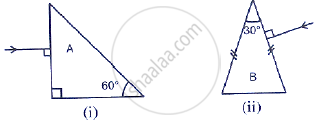Advertisements
Advertisements
Question
Trace a ray of light incident at 30° on a surface if travelling from air to glass. What is the angle of refraction in this case? (R.I. for glass = 3/2).
Solution

aμg = `sin"i"/sin"r"`
∴ `3/2=(sin30°)/sin"r"`
∴ Sin r = `2/3xxsin30°`
But sin 30° = `1/2`
∴ sin r = `2/3xx1/2`
= `1/3`
∴ sin r = 0.3334
∴ sin r = 19°30′.
Angle of refraction for air to glass = 19°30′.
APPEARS IN
RELATED QUESTIONS
Which colour of light travels fastest in any medium except air?
A monochromatic ray of light passes from air to glass. The wavelength of light in air is λ, the speed of light in air is c and in glass is V. If the absolute refractive index of glass is 1.5, write down
- the relationship between c and V,
- the wavelength of light in glass.
An object is viewed through a glass prism with its vertex pointing upwards. It appears to be displaced upward. Explain the reason.
Fig 4.31 below shows a light ray of single colour incident normally on two prisms A and B. In each case draw the path of the ray of light as it enters and emerges out of the prism. Mark the angle wherever necessary.

A Water pond appears to be 2.7 m deep. If the refractive index of water is 4/3, find the actual depth of the pond.
In an experiment of finding the refractive index of glass, if blue light is replaced by the red light, how will the refractive index of glass change? Give reason in support of your answer.
The critical angle for glass-air interface is :
Name one main factor on which the direction of bending of a ray of light depends.
Why does the sun appear bigger during sunset or sunrise?
Light passes through a rectangular glass slab and through a triangular glass prism. In what way does the direction of the two emergent beams differ and why?
